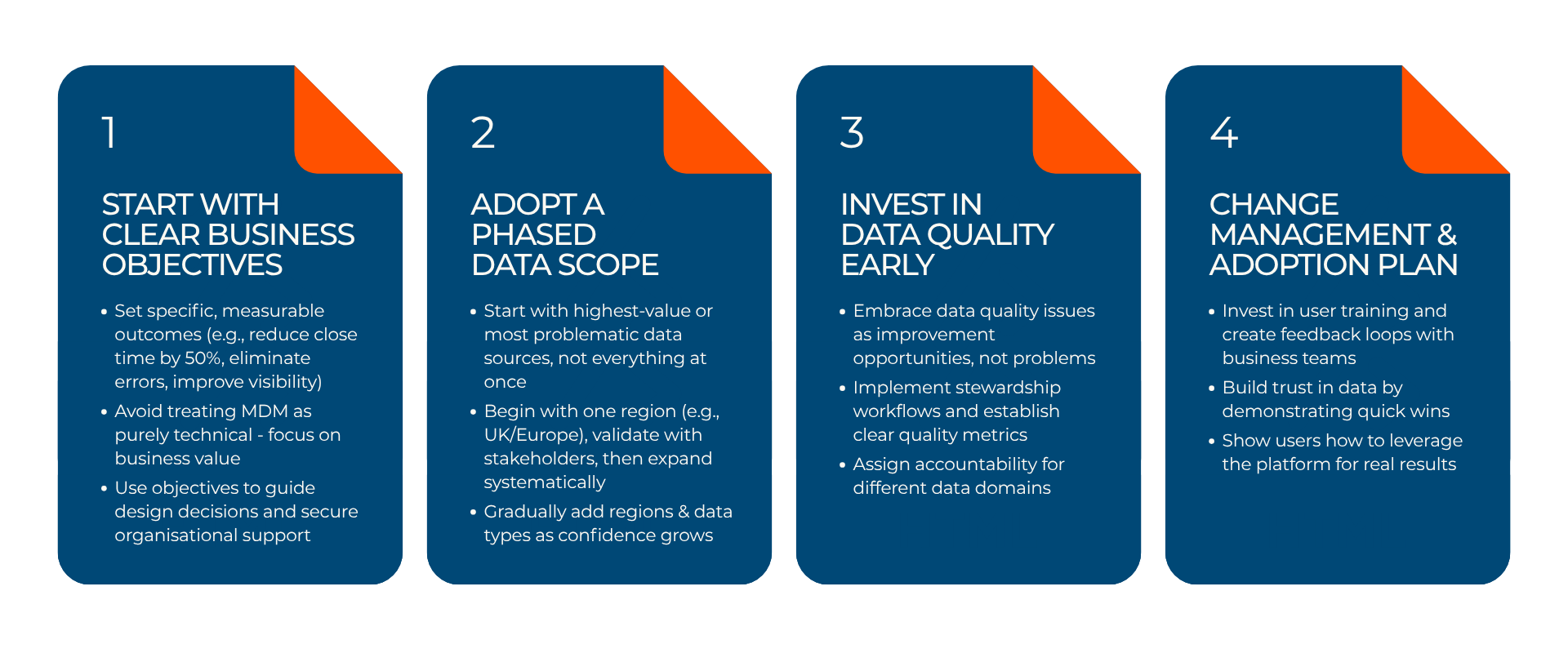Following from Part 1's foundation on why Master Data Management (MDM) matters, we now explore how to implement it effectively and harness AI to drive competitive advantage.
In an industry managing $130 trillion in assets globally (Aiviq, 2025), asset managers face a critical challenge: fragmented client data scattered across hundreds of sources, creating operational inefficiencies that cost the industry an estimated $1 billion annually. Master data management (MDM) has emerged as the essential foundation for modern asset management operations, transforming how firms manage client relationships, report financials, and make strategic decisions. But this time it's different - AI has fundamentally changed the equation. The opportunity to reduce costs and improve quality at scale with fewer people is now more real than ever.
Implementing Master Data Management: A Practical Approach
Successfully implementing master data management requires careful planning, appropriate resourcing, and realistic expectations. Based on industry experience, here's what asset managers should consider:

Start with clear business objectives. Avoid the trap of pursuing MDM as a purely technical initiative. Define specific outcomes you need to achieve: reducing monthly close time by 50%, eliminating rebate payment errors, enabling global sales visibility, or improving client profitability insights. These business objectives will drive design decisions and help maintain organisational support.
Adopt a phased approach to data scope. Begin with your highest-value asset pools or most problematic data sources rather than attempting to onboard everything simultaneously. A typical implementation might start with UK and European distribution data, validate the approach with key stakeholders, then expand to additional regions and vehicle types systematically.
Invest in data quality from day one. Master data management will expose data quality issues that previously remained hidden in fragmented systems. Rather than viewing this as a problem, embrace it as an opportunity to drive systematic improvement. Implement stewardship workflows, establish data quality metrics, and assign clear accountability for different data domains.
Plan for change management and adoption. Technology alone won't deliver value if users don't trust the data or understand how to leverage it. Invest in training, create feedback loops with business users, and demonstrate quick wins that build confidence in the new platform.
Modern implementations typically run over 16 weeks from mobilisation through go-live, with collaborative effort between the platform provider and client teams across solution design, deployment and configuration, testing, and rollout. The investment in project management, business analysis, and stakeholder engagement proves essential for long-term success.
The Future: AI-Powered Intelligence Built on MDM Foundations
Master data management isn't simply about organising existing data - it's about creating the foundation for next-generation capabilities that will define competitive advantage in asset management. Artificial intelligence and machine learning require high-quality, structured data to deliver meaningful results. Firms that have invested in robust master data management can now deploy AI use cases that were previously impossible:
%201.png)
Automated matching and mastering using advanced algorithms achieves accuracy rates that manual processes could never sustain at scale, enabling continuous AUM attribution across all customers whilst maintaining attribution accuracy even as client bases grow.
Predictive retention risk modelling analyses client behaviour patterns to quantify retention risk by different factors, enabling proactive relationship management before clients redeem. This transforms client servicing from reactive to strategic.
AI-powered growth opportunity identification surfaces strategic actions and client propensity insights, helping relationship managers focus their efforts on the highest-potential opportunities rather than intuition-based prioritisation.
Intelligent third-party data processing and anomaly detection monitors thousands of daily data packs autonomously, identifying processing issues and providing automated remediation recommendations that reduce operational burden on data teams.
These AI capabilities aren't bolt-on features or generic chatbots - they're intelligence-native capabilities embedded across the entire client lifecycle, delivering measurable competitive advantage through automated insights and real-time intelligence.
The firms winning in today's competitive landscape recognise that excellence in master data management isn't optional - it's the foundation upon which all other strategic initiatives depend.
Advanced master data management platforms handle these calculations through configurable rules engines whilst maintaining full audit trails. The system processes millions of transactions with incremental processing capabilities, supports period locking for regulatory compliance, enables temporal reporting for point-in-time analysis, and facilitates historical restatements when methodologies change.
Master Data Management as Strategic Imperative
The fragmented client data challenges facing asset managers aren't going away - they're intensifying as distribution channels multiply, regulatory requirements expand, and competitive pressures increase. Master data management has evolved from a technical nice-to-have to a strategic imperative that directly impacts operational efficiency, revenue protection, and growth enablement.
Firms that establish robust master data management capabilities gain a single source of truth for client information that reduces operational risk, accelerates financial reporting, improves decision-making quality, ensures regulatory compliance, and creates the foundation for AI-powered competitive advantages.
The question facing asset management leaders isn't whether to invest in master data management, but how quickly they can implement it before the costs of fragmentation - in operational inefficiency, revenue leakage, and missed opportunities - become unsustainable.
For asset managers ready to transform their client data infrastructure, the path forward begins with understanding current-state challenges, defining clear business objectives, and partnering with proven platforms that combine deep industry expertise with cutting-edge technology capabilities.


.png)


